Population Studies Report: Australia's Population Trends and Policy
VerifiedAdded on 2022/12/27
|20
|4499
|1
Report
AI Summary
This report provides a comprehensive analysis of Australia's population dynamics, covering socio-economic and geographic descriptions, population growth trends, and component analyses of fertility, mortality, and migration. It delves into major demographic issues, including migration challenges and the Pacific Solution. The report examines Australia's current population policies and proposes a relevant and achievable population policy, outlining its key elements, rationale, and implementation strategies. The analysis includes historical data, current statistics, and future projections, offering a detailed understanding of Australia's demographic landscape and policy considerations. The report uses data from ABS.gov.au and other governmental reports to analyze the population trends and issues in Australia.
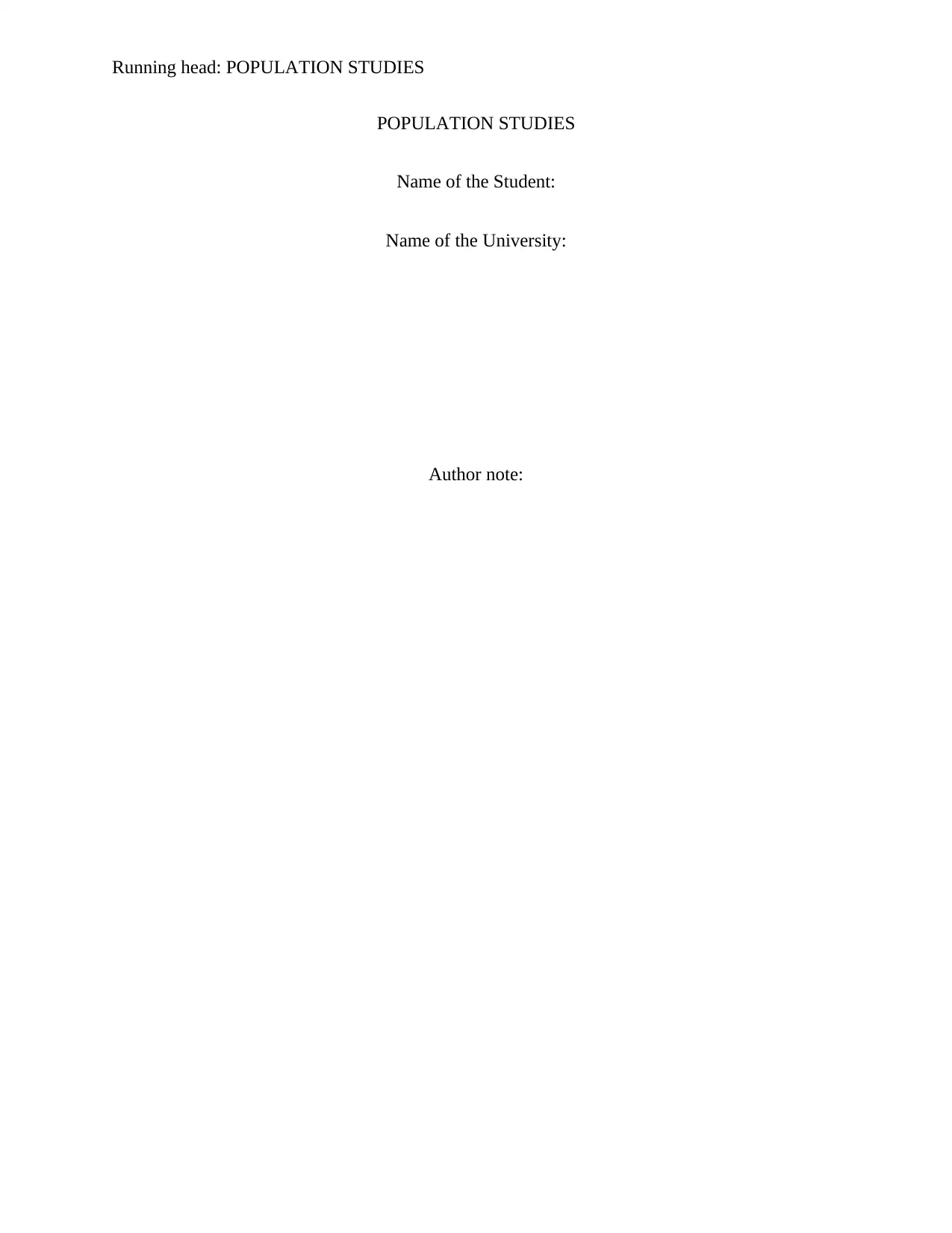
Running head: POPULATION STUDIES
POPULATION STUDIES
Name of the Student:
Name of the University:
Author note:
POPULATION STUDIES
Name of the Student:
Name of the University:
Author note:
Paraphrase This Document
Need a fresh take? Get an instant paraphrase of this document with our AI Paraphraser
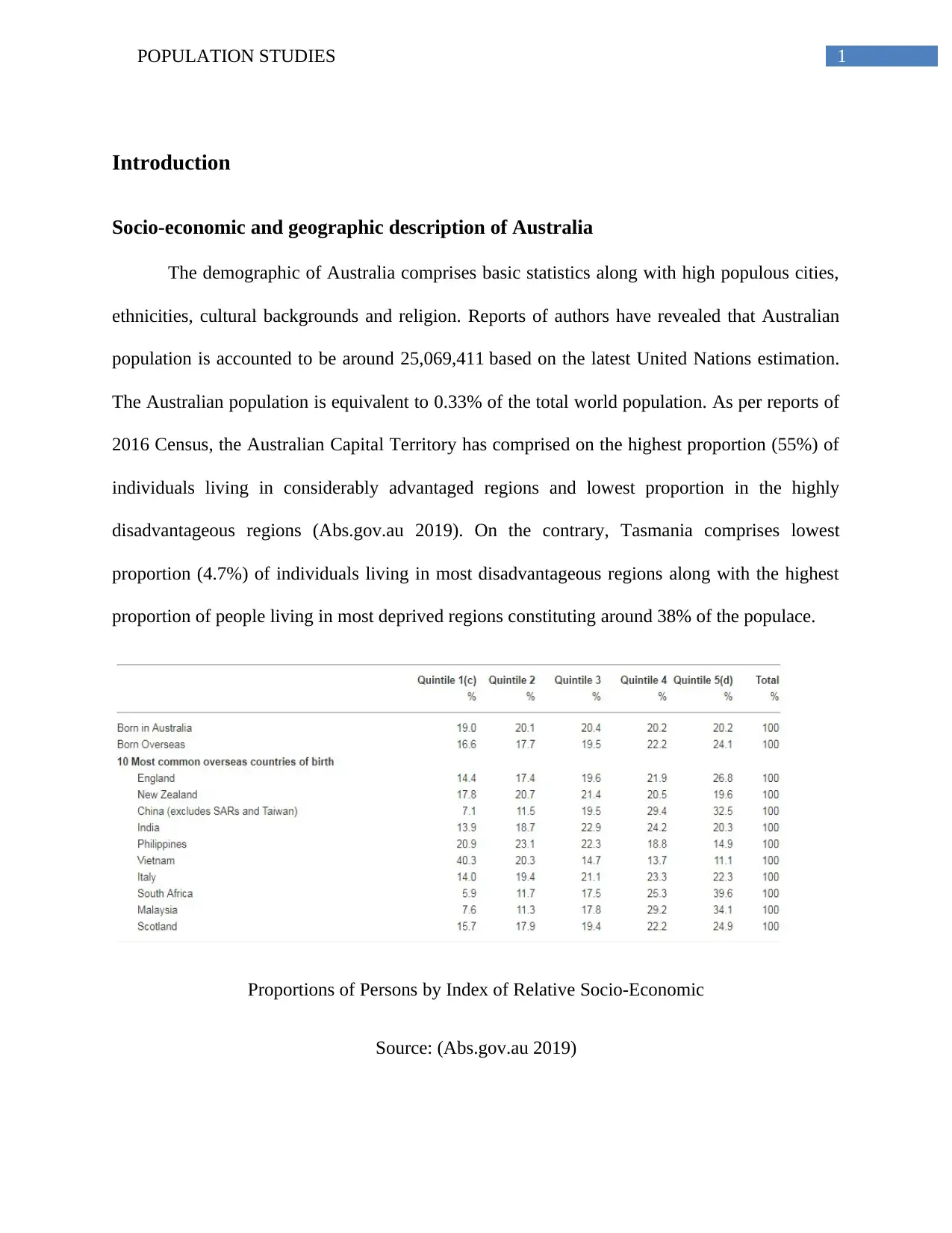
1POPULATION STUDIES
Introduction
Socio-economic and geographic description of Australia
The demographic of Australia comprises basic statistics along with high populous cities,
ethnicities, cultural backgrounds and religion. Reports of authors have revealed that Australian
population is accounted to be around 25,069,411 based on the latest United Nations estimation.
The Australian population is equivalent to 0.33% of the total world population. As per reports of
2016 Census, the Australian Capital Territory has comprised on the highest proportion (55%) of
individuals living in considerably advantaged regions and lowest proportion in the highly
disadvantageous regions (Abs.gov.au 2019). On the contrary, Tasmania comprises lowest
proportion (4.7%) of individuals living in most disadvantageous regions along with the highest
proportion of people living in most deprived regions constituting around 38% of the populace.
Proportions of Persons by Index of Relative Socio-Economic
Source: (Abs.gov.au 2019)
Introduction
Socio-economic and geographic description of Australia
The demographic of Australia comprises basic statistics along with high populous cities,
ethnicities, cultural backgrounds and religion. Reports of authors have revealed that Australian
population is accounted to be around 25,069,411 based on the latest United Nations estimation.
The Australian population is equivalent to 0.33% of the total world population. As per reports of
2016 Census, the Australian Capital Territory has comprised on the highest proportion (55%) of
individuals living in considerably advantaged regions and lowest proportion in the highly
disadvantageous regions (Abs.gov.au 2019). On the contrary, Tasmania comprises lowest
proportion (4.7%) of individuals living in most disadvantageous regions along with the highest
proportion of people living in most deprived regions constituting around 38% of the populace.
Proportions of Persons by Index of Relative Socio-Economic
Source: (Abs.gov.au 2019)
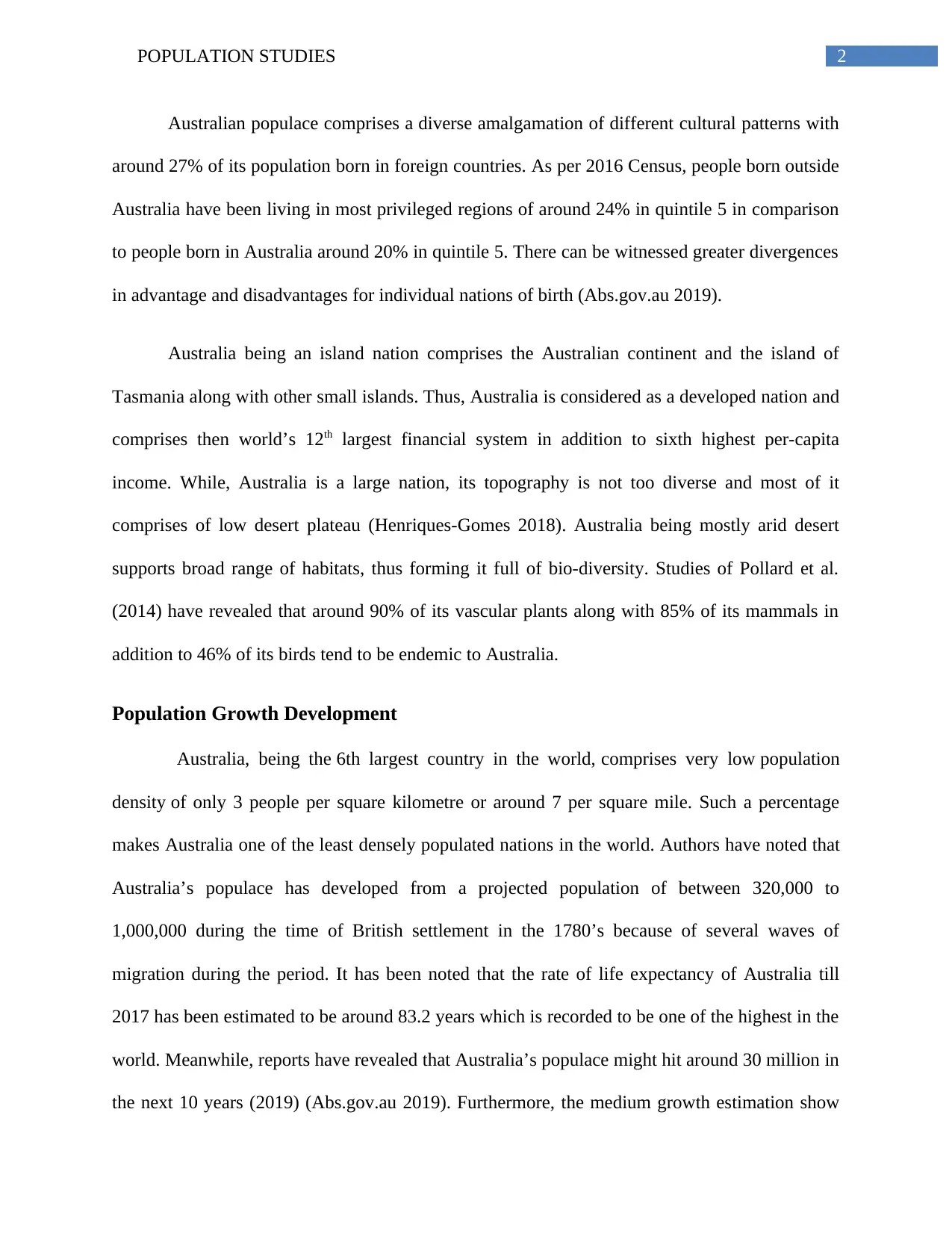
2POPULATION STUDIES
Australian populace comprises a diverse amalgamation of different cultural patterns with
around 27% of its population born in foreign countries. As per 2016 Census, people born outside
Australia have been living in most privileged regions of around 24% in quintile 5 in comparison
to people born in Australia around 20% in quintile 5. There can be witnessed greater divergences
in advantage and disadvantages for individual nations of birth (Abs.gov.au 2019).
Australia being an island nation comprises the Australian continent and the island of
Tasmania along with other small islands. Thus, Australia is considered as a developed nation and
comprises then world’s 12th largest financial system in addition to sixth highest per-capita
income. While, Australia is a large nation, its topography is not too diverse and most of it
comprises of low desert plateau (Henriques-Gomes 2018). Australia being mostly arid desert
supports broad range of habitats, thus forming it full of bio-diversity. Studies of Pollard et al.
(2014) have revealed that around 90% of its vascular plants along with 85% of its mammals in
addition to 46% of its birds tend to be endemic to Australia.
Population Growth Development
Australia, being the 6th largest country in the world, comprises very low population
density of only 3 people per square kilometre or around 7 per square mile. Such a percentage
makes Australia one of the least densely populated nations in the world. Authors have noted that
Australia’s populace has developed from a projected population of between 320,000 to
1,000,000 during the time of British settlement in the 1780’s because of several waves of
migration during the period. It has been noted that the rate of life expectancy of Australia till
2017 has been estimated to be around 83.2 years which is recorded to be one of the highest in the
world. Meanwhile, reports have revealed that Australia’s populace might hit around 30 million in
the next 10 years (2019) (Abs.gov.au 2019). Furthermore, the medium growth estimation show
Australian populace comprises a diverse amalgamation of different cultural patterns with
around 27% of its population born in foreign countries. As per 2016 Census, people born outside
Australia have been living in most privileged regions of around 24% in quintile 5 in comparison
to people born in Australia around 20% in quintile 5. There can be witnessed greater divergences
in advantage and disadvantages for individual nations of birth (Abs.gov.au 2019).
Australia being an island nation comprises the Australian continent and the island of
Tasmania along with other small islands. Thus, Australia is considered as a developed nation and
comprises then world’s 12th largest financial system in addition to sixth highest per-capita
income. While, Australia is a large nation, its topography is not too diverse and most of it
comprises of low desert plateau (Henriques-Gomes 2018). Australia being mostly arid desert
supports broad range of habitats, thus forming it full of bio-diversity. Studies of Pollard et al.
(2014) have revealed that around 90% of its vascular plants along with 85% of its mammals in
addition to 46% of its birds tend to be endemic to Australia.
Population Growth Development
Australia, being the 6th largest country in the world, comprises very low population
density of only 3 people per square kilometre or around 7 per square mile. Such a percentage
makes Australia one of the least densely populated nations in the world. Authors have noted that
Australia’s populace has developed from a projected population of between 320,000 to
1,000,000 during the time of British settlement in the 1780’s because of several waves of
migration during the period. It has been noted that the rate of life expectancy of Australia till
2017 has been estimated to be around 83.2 years which is recorded to be one of the highest in the
world. Meanwhile, reports have revealed that Australia’s populace might hit around 30 million in
the next 10 years (2019) (Abs.gov.au 2019). Furthermore, the medium growth estimation show
⊘ This is a preview!⊘
Do you want full access?
Subscribe today to unlock all pages.

Trusted by 1+ million students worldwide
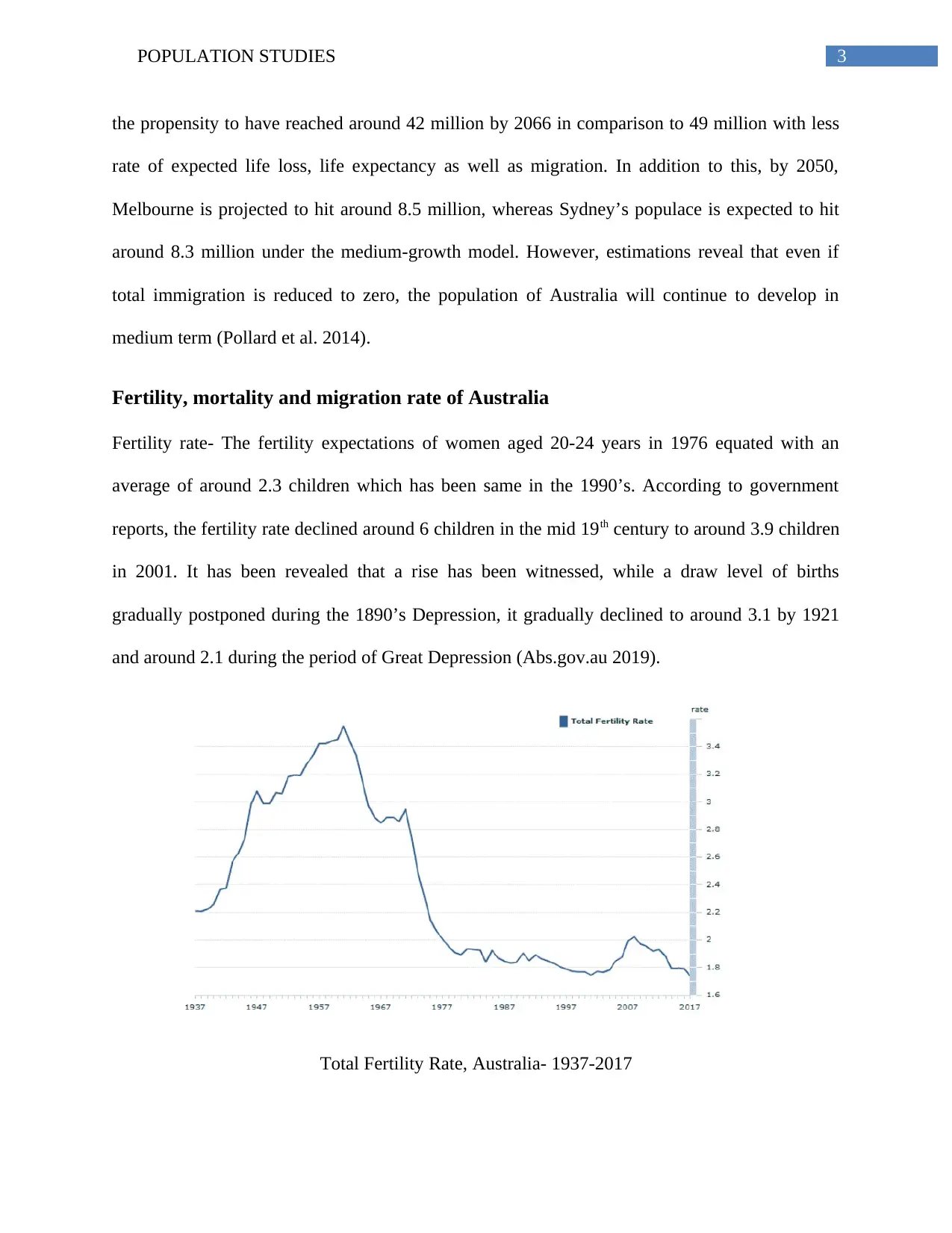
3POPULATION STUDIES
the propensity to have reached around 42 million by 2066 in comparison to 49 million with less
rate of expected life loss, life expectancy as well as migration. In addition to this, by 2050,
Melbourne is projected to hit around 8.5 million, whereas Sydney’s populace is expected to hit
around 8.3 million under the medium-growth model. However, estimations reveal that even if
total immigration is reduced to zero, the population of Australia will continue to develop in
medium term (Pollard et al. 2014).
Fertility, mortality and migration rate of Australia
Fertility rate- The fertility expectations of women aged 20-24 years in 1976 equated with an
average of around 2.3 children which has been same in the 1990’s. According to government
reports, the fertility rate declined around 6 children in the mid 19th century to around 3.9 children
in 2001. It has been revealed that a rise has been witnessed, while a draw level of births
gradually postponed during the 1890’s Depression, it gradually declined to around 3.1 by 1921
and around 2.1 during the period of Great Depression (Abs.gov.au 2019).
Total Fertility Rate, Australia- 1937-2017
the propensity to have reached around 42 million by 2066 in comparison to 49 million with less
rate of expected life loss, life expectancy as well as migration. In addition to this, by 2050,
Melbourne is projected to hit around 8.5 million, whereas Sydney’s populace is expected to hit
around 8.3 million under the medium-growth model. However, estimations reveal that even if
total immigration is reduced to zero, the population of Australia will continue to develop in
medium term (Pollard et al. 2014).
Fertility, mortality and migration rate of Australia
Fertility rate- The fertility expectations of women aged 20-24 years in 1976 equated with an
average of around 2.3 children which has been same in the 1990’s. According to government
reports, the fertility rate declined around 6 children in the mid 19th century to around 3.9 children
in 2001. It has been revealed that a rise has been witnessed, while a draw level of births
gradually postponed during the 1890’s Depression, it gradually declined to around 3.1 by 1921
and around 2.1 during the period of Great Depression (Abs.gov.au 2019).
Total Fertility Rate, Australia- 1937-2017
Paraphrase This Document
Need a fresh take? Get an instant paraphrase of this document with our AI Paraphraser
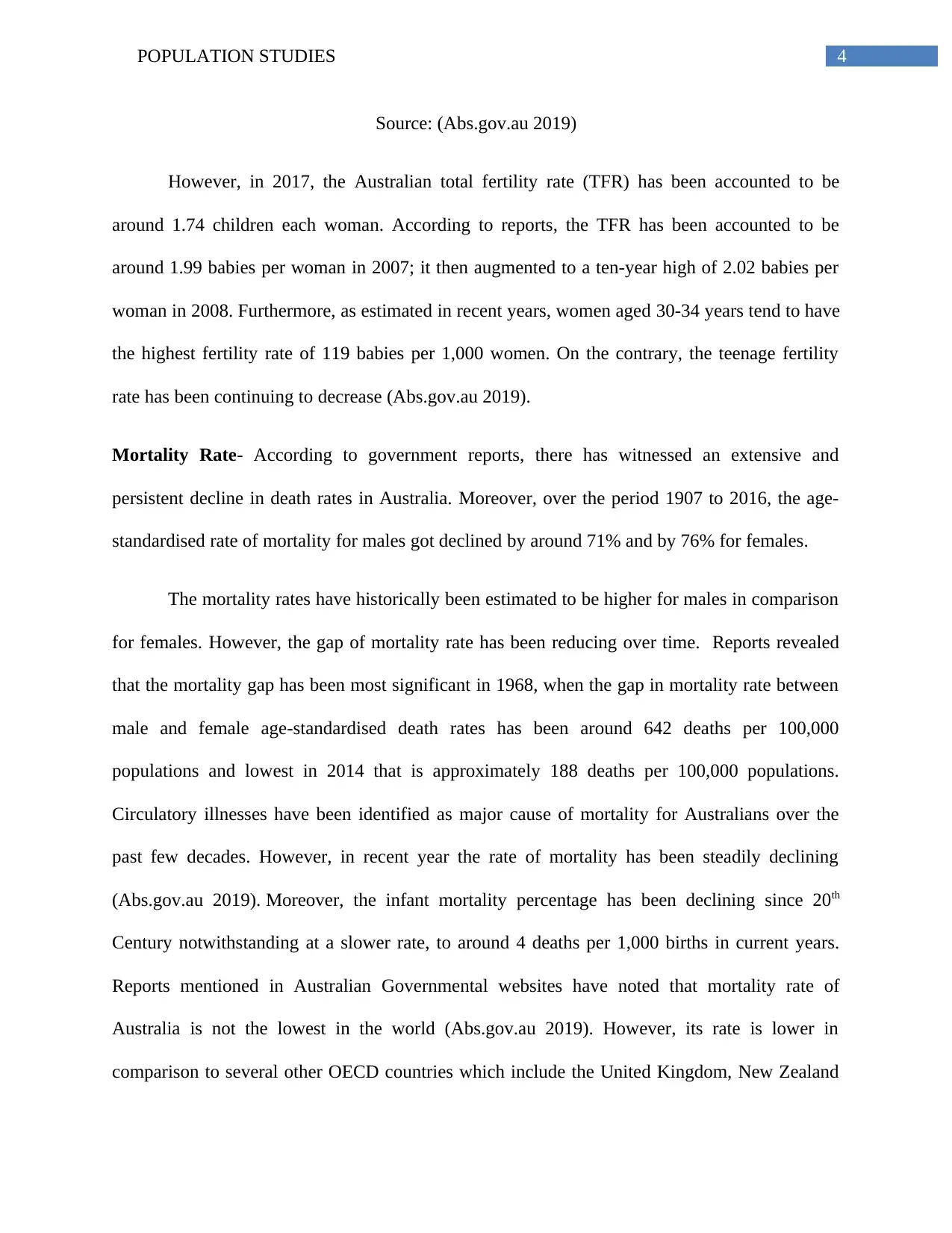
4POPULATION STUDIES
Source: (Abs.gov.au 2019)
However, in 2017, the Australian total fertility rate (TFR) has been accounted to be
around 1.74 children each woman. According to reports, the TFR has been accounted to be
around 1.99 babies per woman in 2007; it then augmented to a ten-year high of 2.02 babies per
woman in 2008. Furthermore, as estimated in recent years, women aged 30-34 years tend to have
the highest fertility rate of 119 babies per 1,000 women. On the contrary, the teenage fertility
rate has been continuing to decrease (Abs.gov.au 2019).
Mortality Rate- According to government reports, there has witnessed an extensive and
persistent decline in death rates in Australia. Moreover, over the period 1907 to 2016, the age-
standardised rate of mortality for males got declined by around 71% and by 76% for females.
The mortality rates have historically been estimated to be higher for males in comparison
for females. However, the gap of mortality rate has been reducing over time. Reports revealed
that the mortality gap has been most significant in 1968, when the gap in mortality rate between
male and female age-standardised death rates has been around 642 deaths per 100,000
populations and lowest in 2014 that is approximately 188 deaths per 100,000 populations.
Circulatory illnesses have been identified as major cause of mortality for Australians over the
past few decades. However, in recent year the rate of mortality has been steadily declining
(Abs.gov.au 2019). Moreover, the infant mortality percentage has been declining since 20th
Century notwithstanding at a slower rate, to around 4 deaths per 1,000 births in current years.
Reports mentioned in Australian Governmental websites have noted that mortality rate of
Australia is not the lowest in the world (Abs.gov.au 2019). However, its rate is lower in
comparison to several other OECD countries which include the United Kingdom, New Zealand
Source: (Abs.gov.au 2019)
However, in 2017, the Australian total fertility rate (TFR) has been accounted to be
around 1.74 children each woman. According to reports, the TFR has been accounted to be
around 1.99 babies per woman in 2007; it then augmented to a ten-year high of 2.02 babies per
woman in 2008. Furthermore, as estimated in recent years, women aged 30-34 years tend to have
the highest fertility rate of 119 babies per 1,000 women. On the contrary, the teenage fertility
rate has been continuing to decrease (Abs.gov.au 2019).
Mortality Rate- According to government reports, there has witnessed an extensive and
persistent decline in death rates in Australia. Moreover, over the period 1907 to 2016, the age-
standardised rate of mortality for males got declined by around 71% and by 76% for females.
The mortality rates have historically been estimated to be higher for males in comparison
for females. However, the gap of mortality rate has been reducing over time. Reports revealed
that the mortality gap has been most significant in 1968, when the gap in mortality rate between
male and female age-standardised death rates has been around 642 deaths per 100,000
populations and lowest in 2014 that is approximately 188 deaths per 100,000 populations.
Circulatory illnesses have been identified as major cause of mortality for Australians over the
past few decades. However, in recent year the rate of mortality has been steadily declining
(Abs.gov.au 2019). Moreover, the infant mortality percentage has been declining since 20th
Century notwithstanding at a slower rate, to around 4 deaths per 1,000 births in current years.
Reports mentioned in Australian Governmental websites have noted that mortality rate of
Australia is not the lowest in the world (Abs.gov.au 2019). However, its rate is lower in
comparison to several other OECD countries which include the United Kingdom, New Zealand
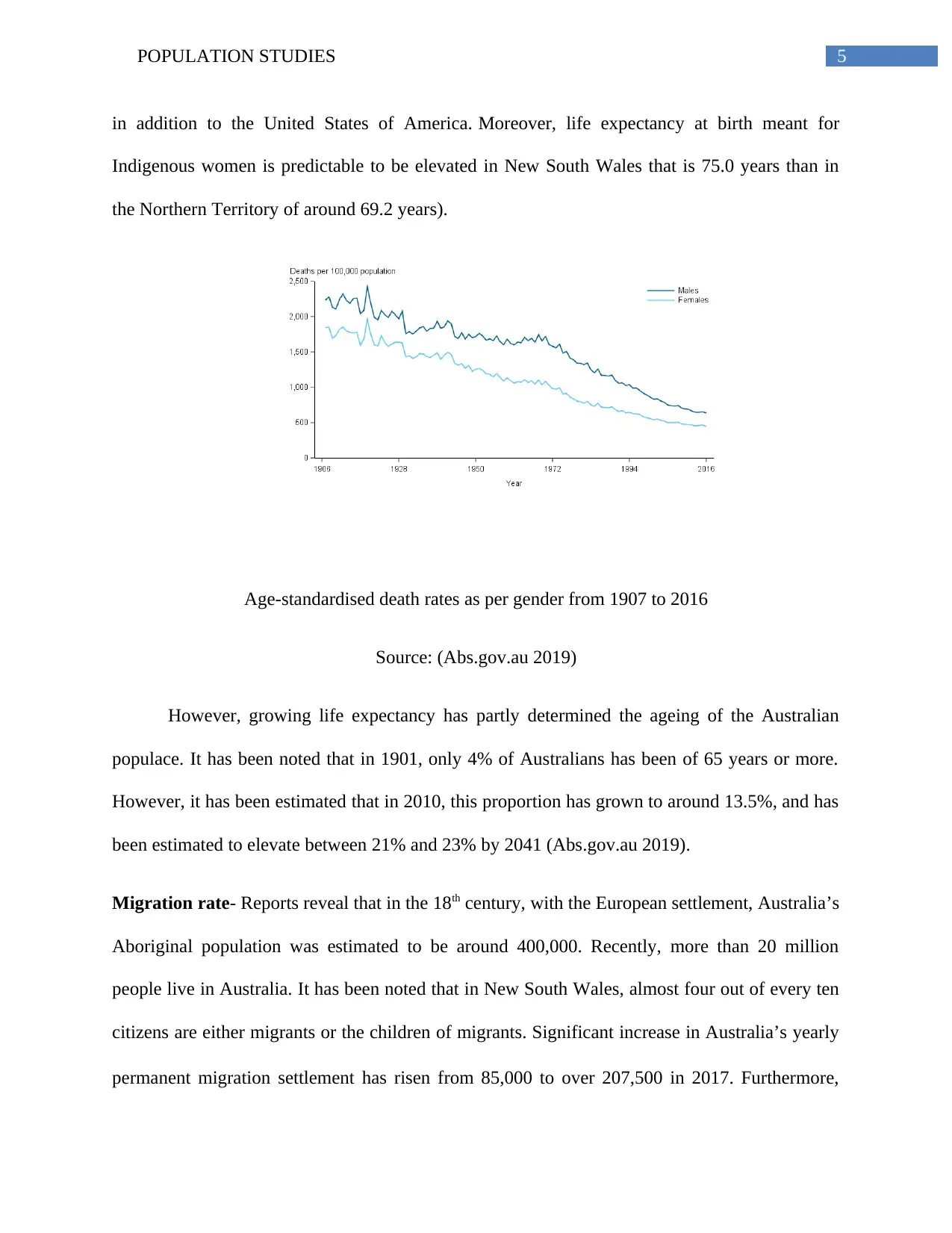
5POPULATION STUDIES
in addition to the United States of America. Moreover, life expectancy at birth meant for
Indigenous women is predictable to be elevated in New South Wales that is 75.0 years than in
the Northern Territory of around 69.2 years).
Age-standardised death rates as per gender from 1907 to 2016
Source: (Abs.gov.au 2019)
However, growing life expectancy has partly determined the ageing of the Australian
populace. It has been noted that in 1901, only 4% of Australians has been of 65 years or more.
However, it has been estimated that in 2010, this proportion has grown to around 13.5%, and has
been estimated to elevate between 21% and 23% by 2041 (Abs.gov.au 2019).
Migration rate- Reports reveal that in the 18th century, with the European settlement, Australia’s
Aboriginal population was estimated to be around 400,000. Recently, more than 20 million
people live in Australia. It has been noted that in New South Wales, almost four out of every ten
citizens are either migrants or the children of migrants. Significant increase in Australia’s yearly
permanent migration settlement has risen from 85,000 to over 207,500 in 2017. Furthermore,
in addition to the United States of America. Moreover, life expectancy at birth meant for
Indigenous women is predictable to be elevated in New South Wales that is 75.0 years than in
the Northern Territory of around 69.2 years).
Age-standardised death rates as per gender from 1907 to 2016
Source: (Abs.gov.au 2019)
However, growing life expectancy has partly determined the ageing of the Australian
populace. It has been noted that in 1901, only 4% of Australians has been of 65 years or more.
However, it has been estimated that in 2010, this proportion has grown to around 13.5%, and has
been estimated to elevate between 21% and 23% by 2041 (Abs.gov.au 2019).
Migration rate- Reports reveal that in the 18th century, with the European settlement, Australia’s
Aboriginal population was estimated to be around 400,000. Recently, more than 20 million
people live in Australia. It has been noted that in New South Wales, almost four out of every ten
citizens are either migrants or the children of migrants. Significant increase in Australia’s yearly
permanent migration settlement has risen from 85,000 to over 207,500 in 2017. Furthermore,
⊘ This is a preview!⊘
Do you want full access?
Subscribe today to unlock all pages.

Trusted by 1+ million students worldwide
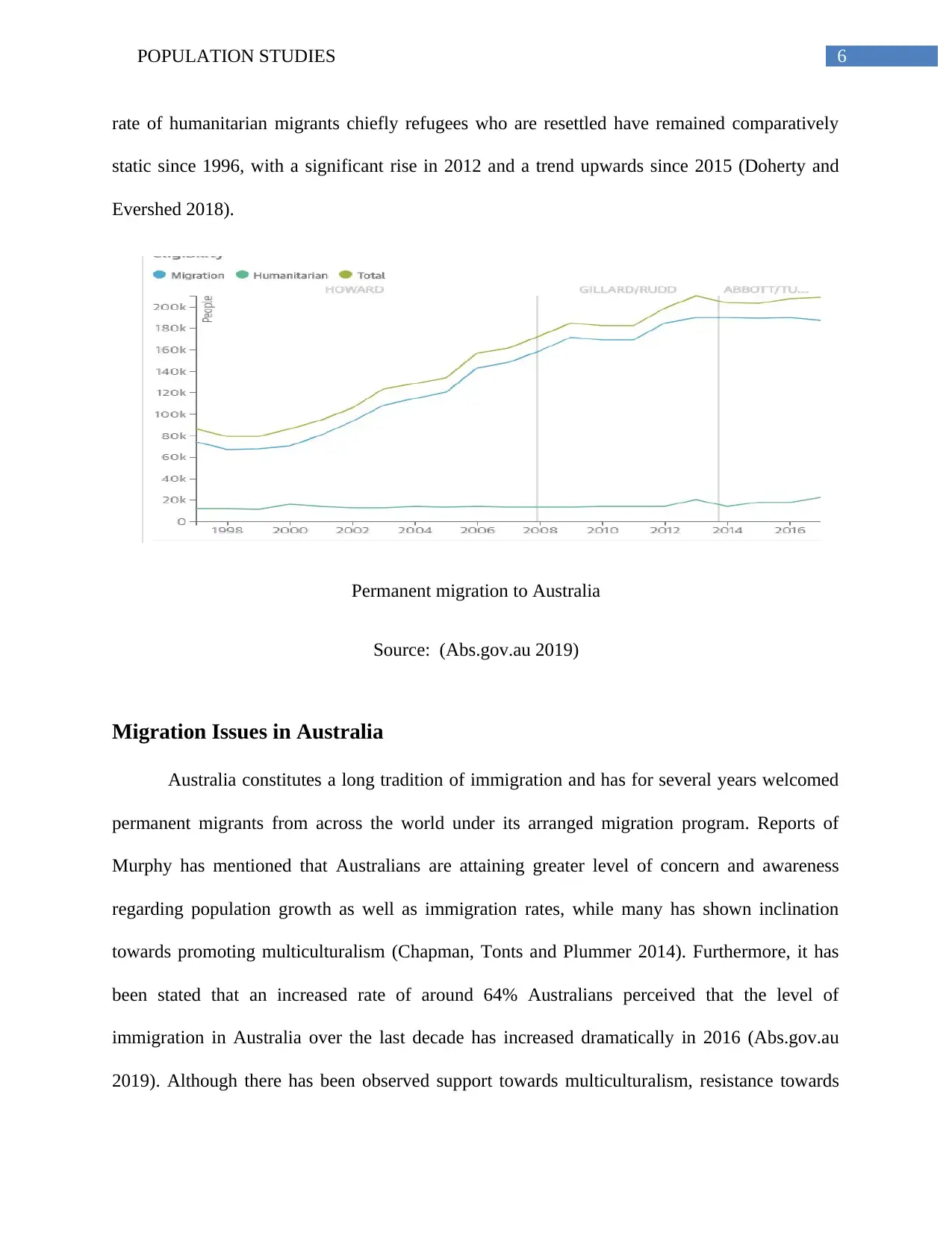
6POPULATION STUDIES
rate of humanitarian migrants chiefly refugees who are resettled have remained comparatively
static since 1996, with a significant rise in 2012 and a trend upwards since 2015 (Doherty and
Evershed 2018).
Permanent migration to Australia
Source: (Abs.gov.au 2019)
Migration Issues in Australia
Australia constitutes a long tradition of immigration and has for several years welcomed
permanent migrants from across the world under its arranged migration program. Reports of
Murphy has mentioned that Australians are attaining greater level of concern and awareness
regarding population growth as well as immigration rates, while many has shown inclination
towards promoting multiculturalism (Chapman, Tonts and Plummer 2014). Furthermore, it has
been stated that an increased rate of around 64% Australians perceived that the level of
immigration in Australia over the last decade has increased dramatically in 2016 (Abs.gov.au
2019). Although there has been observed support towards multiculturalism, resistance towards
rate of humanitarian migrants chiefly refugees who are resettled have remained comparatively
static since 1996, with a significant rise in 2012 and a trend upwards since 2015 (Doherty and
Evershed 2018).
Permanent migration to Australia
Source: (Abs.gov.au 2019)
Migration Issues in Australia
Australia constitutes a long tradition of immigration and has for several years welcomed
permanent migrants from across the world under its arranged migration program. Reports of
Murphy has mentioned that Australians are attaining greater level of concern and awareness
regarding population growth as well as immigration rates, while many has shown inclination
towards promoting multiculturalism (Chapman, Tonts and Plummer 2014). Furthermore, it has
been stated that an increased rate of around 64% Australians perceived that the level of
immigration in Australia over the last decade has increased dramatically in 2016 (Abs.gov.au
2019). Although there has been observed support towards multiculturalism, resistance towards
Paraphrase This Document
Need a fresh take? Get an instant paraphrase of this document with our AI Paraphraser
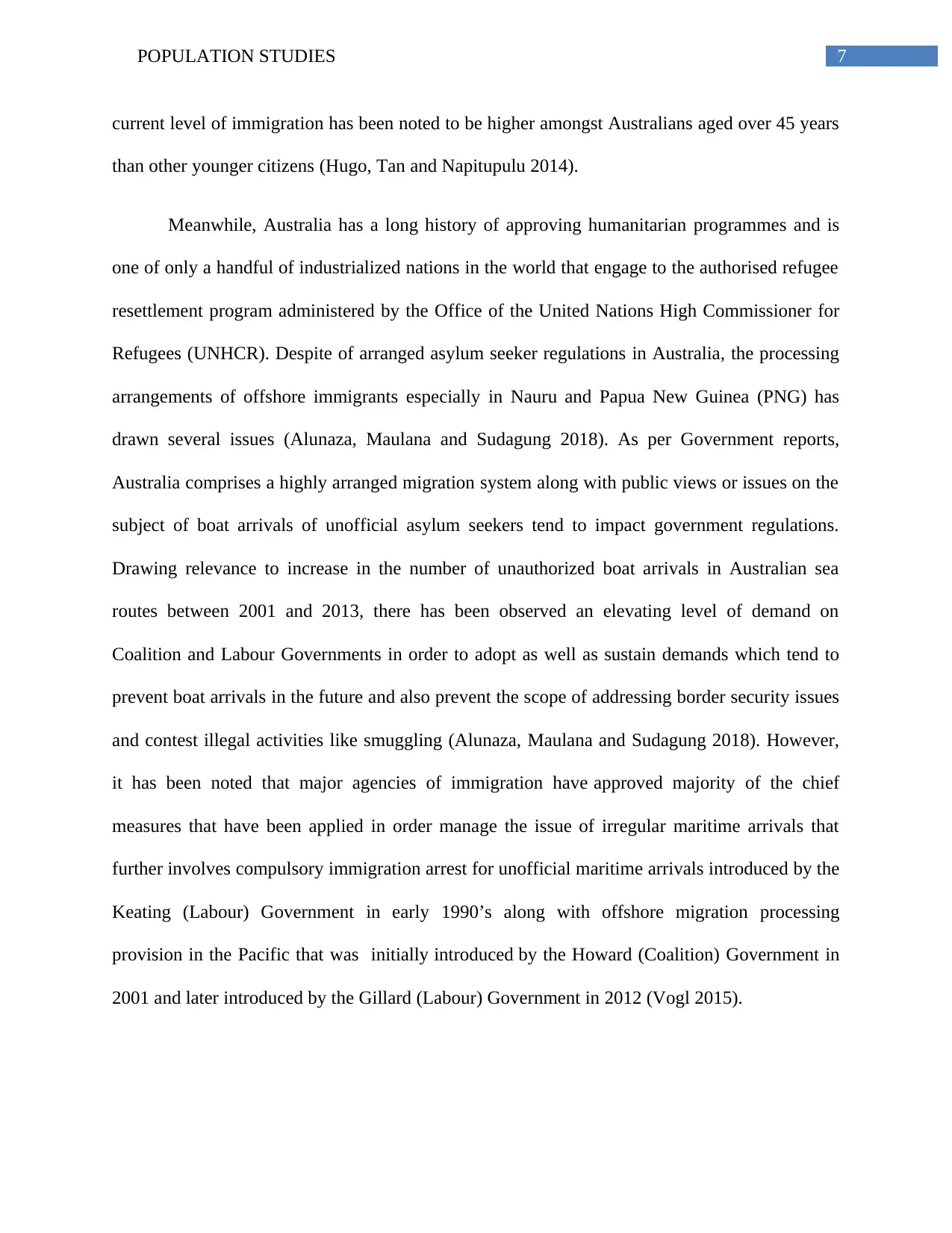
7POPULATION STUDIES
current level of immigration has been noted to be higher amongst Australians aged over 45 years
than other younger citizens (Hugo, Tan and Napitupulu 2014).
Meanwhile, Australia has a long history of approving humanitarian programmes and is
one of only a handful of industrialized nations in the world that engage to the authorised refugee
resettlement program administered by the Office of the United Nations High Commissioner for
Refugees (UNHCR). Despite of arranged asylum seeker regulations in Australia, the processing
arrangements of offshore immigrants especially in Nauru and Papua New Guinea (PNG) has
drawn several issues (Alunaza, Maulana and Sudagung 2018). As per Government reports,
Australia comprises a highly arranged migration system along with public views or issues on the
subject of boat arrivals of unofficial asylum seekers tend to impact government regulations.
Drawing relevance to increase in the number of unauthorized boat arrivals in Australian sea
routes between 2001 and 2013, there has been observed an elevating level of demand on
Coalition and Labour Governments in order to adopt as well as sustain demands which tend to
prevent boat arrivals in the future and also prevent the scope of addressing border security issues
and contest illegal activities like smuggling (Alunaza, Maulana and Sudagung 2018). However,
it has been noted that major agencies of immigration have approved majority of the chief
measures that have been applied in order manage the issue of irregular maritime arrivals that
further involves compulsory immigration arrest for unofficial maritime arrivals introduced by the
Keating (Labour) Government in early 1990’s along with offshore migration processing
provision in the Pacific that was initially introduced by the Howard (Coalition) Government in
2001 and later introduced by the Gillard (Labour) Government in 2012 (Vogl 2015).
current level of immigration has been noted to be higher amongst Australians aged over 45 years
than other younger citizens (Hugo, Tan and Napitupulu 2014).
Meanwhile, Australia has a long history of approving humanitarian programmes and is
one of only a handful of industrialized nations in the world that engage to the authorised refugee
resettlement program administered by the Office of the United Nations High Commissioner for
Refugees (UNHCR). Despite of arranged asylum seeker regulations in Australia, the processing
arrangements of offshore immigrants especially in Nauru and Papua New Guinea (PNG) has
drawn several issues (Alunaza, Maulana and Sudagung 2018). As per Government reports,
Australia comprises a highly arranged migration system along with public views or issues on the
subject of boat arrivals of unofficial asylum seekers tend to impact government regulations.
Drawing relevance to increase in the number of unauthorized boat arrivals in Australian sea
routes between 2001 and 2013, there has been observed an elevating level of demand on
Coalition and Labour Governments in order to adopt as well as sustain demands which tend to
prevent boat arrivals in the future and also prevent the scope of addressing border security issues
and contest illegal activities like smuggling (Alunaza, Maulana and Sudagung 2018). However,
it has been noted that major agencies of immigration have approved majority of the chief
measures that have been applied in order manage the issue of irregular maritime arrivals that
further involves compulsory immigration arrest for unofficial maritime arrivals introduced by the
Keating (Labour) Government in early 1990’s along with offshore migration processing
provision in the Pacific that was initially introduced by the Howard (Coalition) Government in
2001 and later introduced by the Gillard (Labour) Government in 2012 (Vogl 2015).
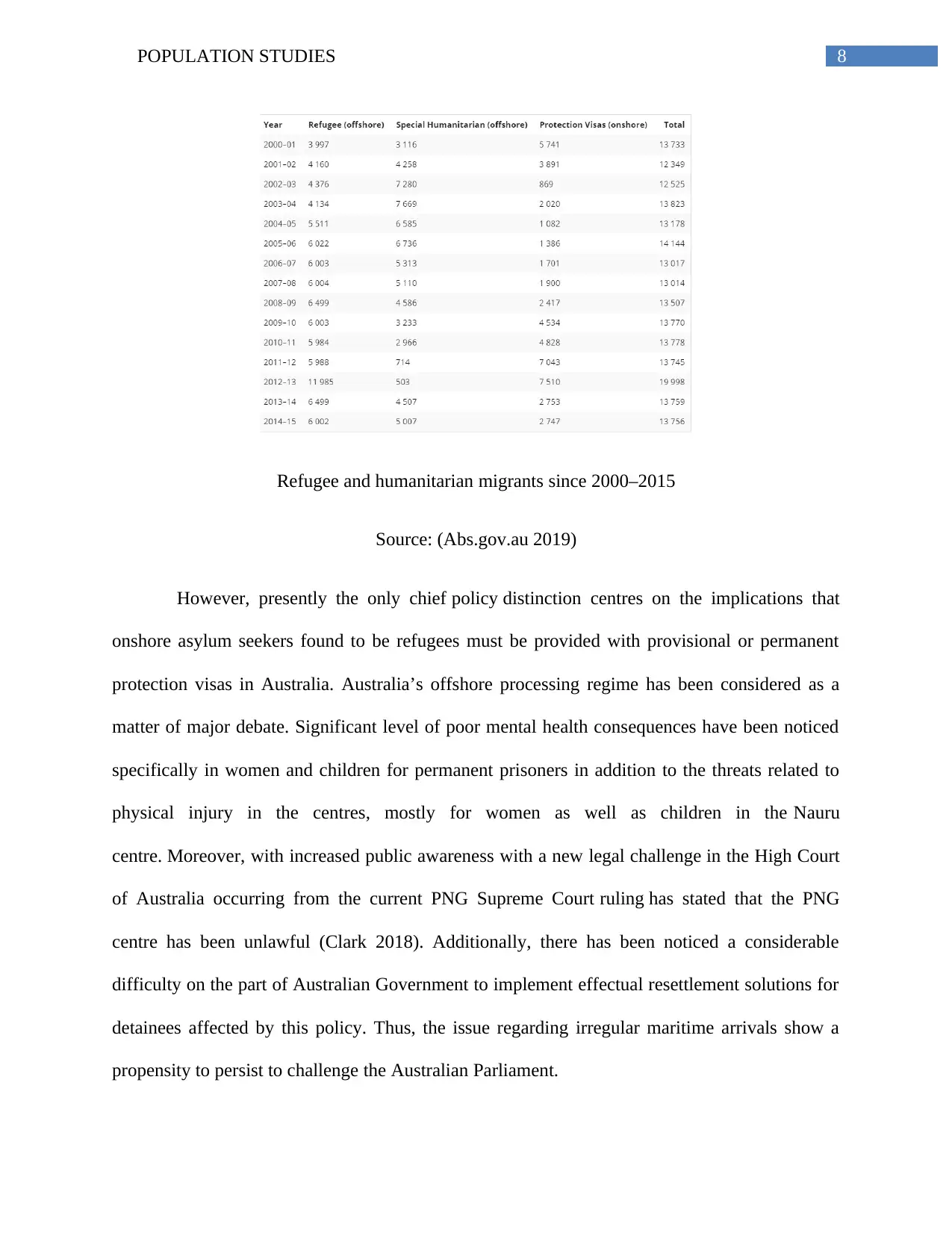
8POPULATION STUDIES
Refugee and humanitarian migrants since 2000–2015
Source: (Abs.gov.au 2019)
However, presently the only chief policy distinction centres on the implications that
onshore asylum seekers found to be refugees must be provided with provisional or permanent
protection visas in Australia. Australia’s offshore processing regime has been considered as a
matter of major debate. Significant level of poor mental health consequences have been noticed
specifically in women and children for permanent prisoners in addition to the threats related to
physical injury in the centres, mostly for women as well as children in the Nauru
centre. Moreover, with increased public awareness with a new legal challenge in the High Court
of Australia occurring from the current PNG Supreme Court ruling has stated that the PNG
centre has been unlawful (Clark 2018). Additionally, there has been noticed a considerable
difficulty on the part of Australian Government to implement effectual resettlement solutions for
detainees affected by this policy. Thus, the issue regarding irregular maritime arrivals show a
propensity to persist to challenge the Australian Parliament.
Refugee and humanitarian migrants since 2000–2015
Source: (Abs.gov.au 2019)
However, presently the only chief policy distinction centres on the implications that
onshore asylum seekers found to be refugees must be provided with provisional or permanent
protection visas in Australia. Australia’s offshore processing regime has been considered as a
matter of major debate. Significant level of poor mental health consequences have been noticed
specifically in women and children for permanent prisoners in addition to the threats related to
physical injury in the centres, mostly for women as well as children in the Nauru
centre. Moreover, with increased public awareness with a new legal challenge in the High Court
of Australia occurring from the current PNG Supreme Court ruling has stated that the PNG
centre has been unlawful (Clark 2018). Additionally, there has been noticed a considerable
difficulty on the part of Australian Government to implement effectual resettlement solutions for
detainees affected by this policy. Thus, the issue regarding irregular maritime arrivals show a
propensity to persist to challenge the Australian Parliament.
⊘ This is a preview!⊘
Do you want full access?
Subscribe today to unlock all pages.

Trusted by 1+ million students worldwide
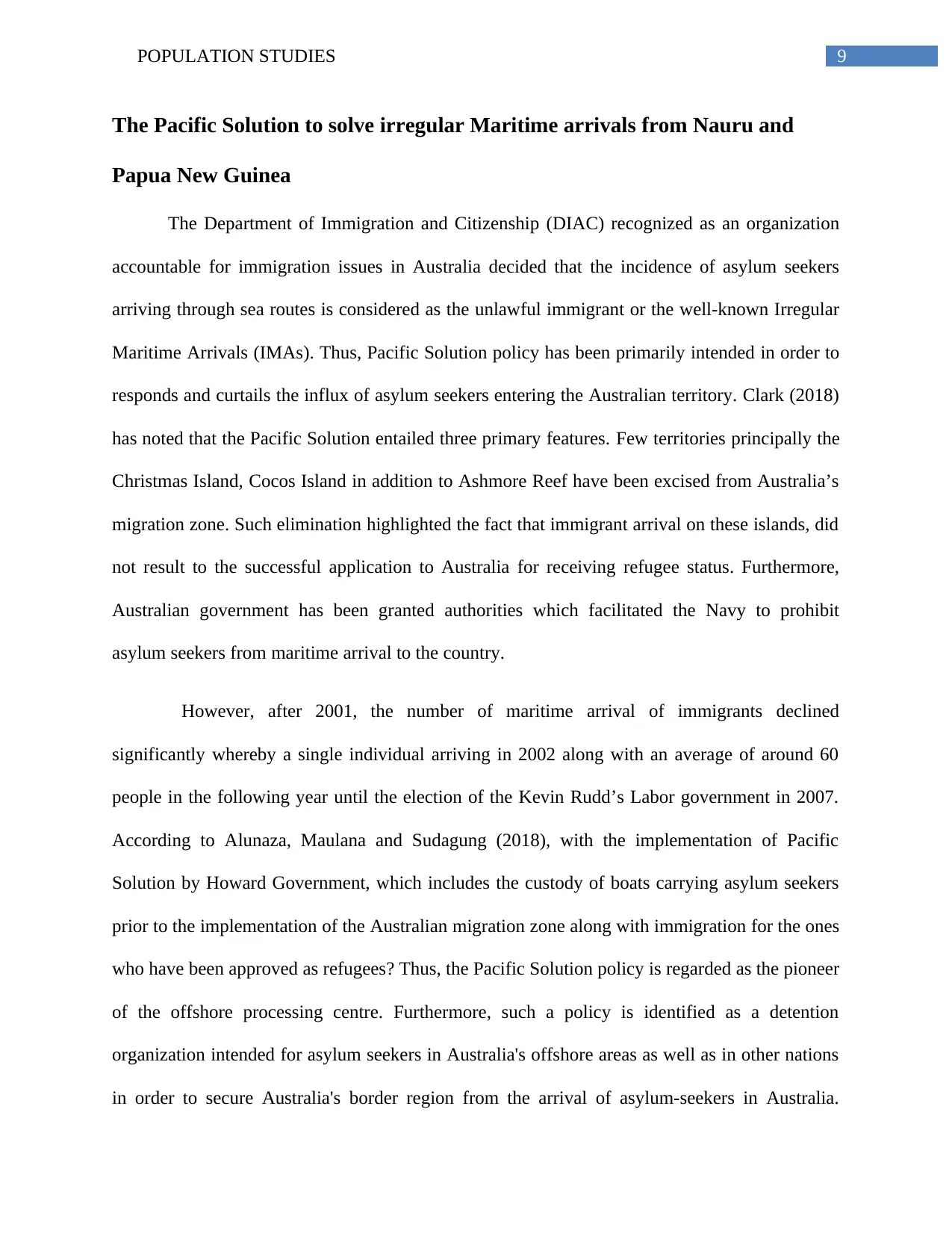
9POPULATION STUDIES
The Pacific Solution to solve irregular Maritime arrivals from Nauru and
Papua New Guinea
The Department of Immigration and Citizenship (DIAC) recognized as an organization
accountable for immigration issues in Australia decided that the incidence of asylum seekers
arriving through sea routes is considered as the unlawful immigrant or the well-known Irregular
Maritime Arrivals (IMAs). Thus, Pacific Solution policy has been primarily intended in order to
responds and curtails the influx of asylum seekers entering the Australian territory. Clark (2018)
has noted that the Pacific Solution entailed three primary features. Few territories principally the
Christmas Island, Cocos Island in addition to Ashmore Reef have been excised from Australia’s
migration zone. Such elimination highlighted the fact that immigrant arrival on these islands, did
not result to the successful application to Australia for receiving refugee status. Furthermore,
Australian government has been granted authorities which facilitated the Navy to prohibit
asylum seekers from maritime arrival to the country.
However, after 2001, the number of maritime arrival of immigrants declined
significantly whereby a single individual arriving in 2002 along with an average of around 60
people in the following year until the election of the Kevin Rudd’s Labor government in 2007.
According to Alunaza, Maulana and Sudagung (2018), with the implementation of Pacific
Solution by Howard Government, which includes the custody of boats carrying asylum seekers
prior to the implementation of the Australian migration zone along with immigration for the ones
who have been approved as refugees? Thus, the Pacific Solution policy is regarded as the pioneer
of the offshore processing centre. Furthermore, such a policy is identified as a detention
organization intended for asylum seekers in Australia's offshore areas as well as in other nations
in order to secure Australia's border region from the arrival of asylum-seekers in Australia.
The Pacific Solution to solve irregular Maritime arrivals from Nauru and
Papua New Guinea
The Department of Immigration and Citizenship (DIAC) recognized as an organization
accountable for immigration issues in Australia decided that the incidence of asylum seekers
arriving through sea routes is considered as the unlawful immigrant or the well-known Irregular
Maritime Arrivals (IMAs). Thus, Pacific Solution policy has been primarily intended in order to
responds and curtails the influx of asylum seekers entering the Australian territory. Clark (2018)
has noted that the Pacific Solution entailed three primary features. Few territories principally the
Christmas Island, Cocos Island in addition to Ashmore Reef have been excised from Australia’s
migration zone. Such elimination highlighted the fact that immigrant arrival on these islands, did
not result to the successful application to Australia for receiving refugee status. Furthermore,
Australian government has been granted authorities which facilitated the Navy to prohibit
asylum seekers from maritime arrival to the country.
However, after 2001, the number of maritime arrival of immigrants declined
significantly whereby a single individual arriving in 2002 along with an average of around 60
people in the following year until the election of the Kevin Rudd’s Labor government in 2007.
According to Alunaza, Maulana and Sudagung (2018), with the implementation of Pacific
Solution by Howard Government, which includes the custody of boats carrying asylum seekers
prior to the implementation of the Australian migration zone along with immigration for the ones
who have been approved as refugees? Thus, the Pacific Solution policy is regarded as the pioneer
of the offshore processing centre. Furthermore, such a policy is identified as a detention
organization intended for asylum seekers in Australia's offshore areas as well as in other nations
in order to secure Australia's border region from the arrival of asylum-seekers in Australia.
Paraphrase This Document
Need a fresh take? Get an instant paraphrase of this document with our AI Paraphraser
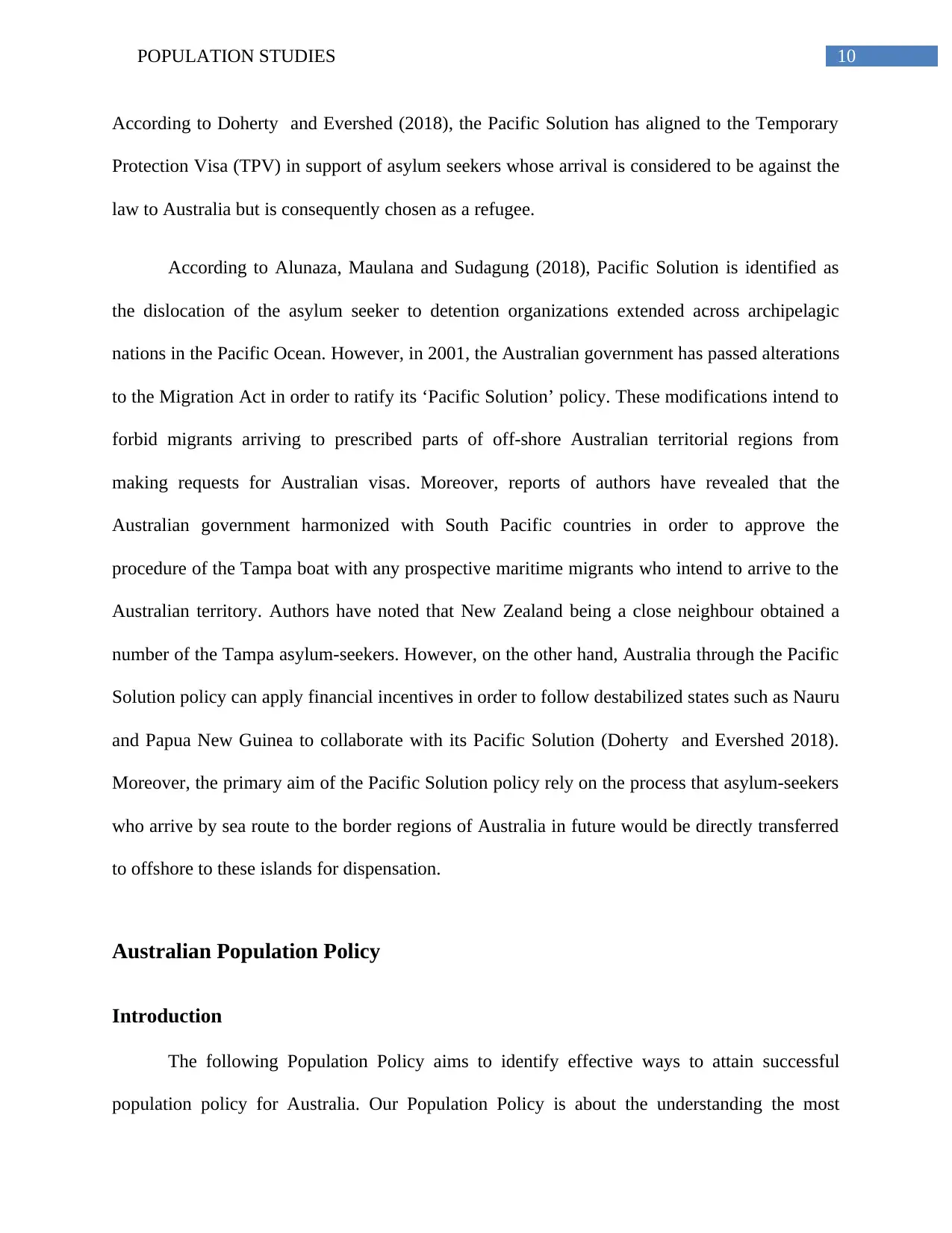
10POPULATION STUDIES
According to Doherty and Evershed (2018), the Pacific Solution has aligned to the Temporary
Protection Visa (TPV) in support of asylum seekers whose arrival is considered to be against the
law to Australia but is consequently chosen as a refugee.
According to Alunaza, Maulana and Sudagung (2018), Pacific Solution is identified as
the dislocation of the asylum seeker to detention organizations extended across archipelagic
nations in the Pacific Ocean. However, in 2001, the Australian government has passed alterations
to the Migration Act in order to ratify its ‘Pacific Solution’ policy. These modifications intend to
forbid migrants arriving to prescribed parts of off-shore Australian territorial regions from
making requests for Australian visas. Moreover, reports of authors have revealed that the
Australian government harmonized with South Pacific countries in order to approve the
procedure of the Tampa boat with any prospective maritime migrants who intend to arrive to the
Australian territory. Authors have noted that New Zealand being a close neighbour obtained a
number of the Tampa asylum-seekers. However, on the other hand, Australia through the Pacific
Solution policy can apply financial incentives in order to follow destabilized states such as Nauru
and Papua New Guinea to collaborate with its Pacific Solution (Doherty and Evershed 2018).
Moreover, the primary aim of the Pacific Solution policy rely on the process that asylum-seekers
who arrive by sea route to the border regions of Australia in future would be directly transferred
to offshore to these islands for dispensation.
Australian Population Policy
Introduction
The following Population Policy aims to identify effective ways to attain successful
population policy for Australia. Our Population Policy is about the understanding the most
According to Doherty and Evershed (2018), the Pacific Solution has aligned to the Temporary
Protection Visa (TPV) in support of asylum seekers whose arrival is considered to be against the
law to Australia but is consequently chosen as a refugee.
According to Alunaza, Maulana and Sudagung (2018), Pacific Solution is identified as
the dislocation of the asylum seeker to detention organizations extended across archipelagic
nations in the Pacific Ocean. However, in 2001, the Australian government has passed alterations
to the Migration Act in order to ratify its ‘Pacific Solution’ policy. These modifications intend to
forbid migrants arriving to prescribed parts of off-shore Australian territorial regions from
making requests for Australian visas. Moreover, reports of authors have revealed that the
Australian government harmonized with South Pacific countries in order to approve the
procedure of the Tampa boat with any prospective maritime migrants who intend to arrive to the
Australian territory. Authors have noted that New Zealand being a close neighbour obtained a
number of the Tampa asylum-seekers. However, on the other hand, Australia through the Pacific
Solution policy can apply financial incentives in order to follow destabilized states such as Nauru
and Papua New Guinea to collaborate with its Pacific Solution (Doherty and Evershed 2018).
Moreover, the primary aim of the Pacific Solution policy rely on the process that asylum-seekers
who arrive by sea route to the border regions of Australia in future would be directly transferred
to offshore to these islands for dispensation.
Australian Population Policy
Introduction
The following Population Policy aims to identify effective ways to attain successful
population policy for Australia. Our Population Policy is about the understanding the most
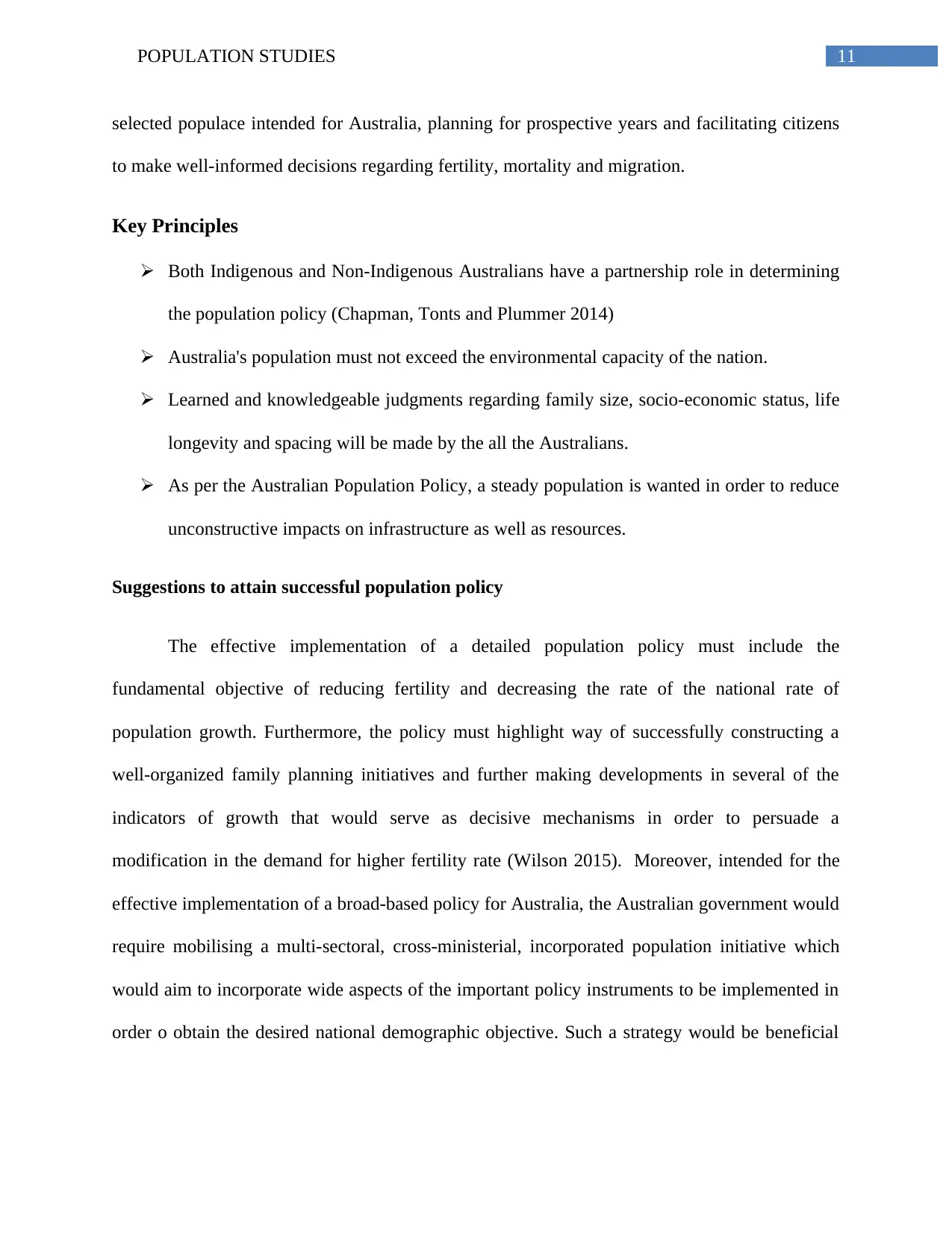
11POPULATION STUDIES
selected populace intended for Australia, planning for prospective years and facilitating citizens
to make well-informed decisions regarding fertility, mortality and migration.
Key Principles
Both Indigenous and Non-Indigenous Australians have a partnership role in determining
the population policy (Chapman, Tonts and Plummer 2014)
Australia's population must not exceed the environmental capacity of the nation.
Learned and knowledgeable judgments regarding family size, socio-economic status, life
longevity and spacing will be made by the all the Australians.
As per the Australian Population Policy, a steady population is wanted in order to reduce
unconstructive impacts on infrastructure as well as resources.
Suggestions to attain successful population policy
The effective implementation of a detailed population policy must include the
fundamental objective of reducing fertility and decreasing the rate of the national rate of
population growth. Furthermore, the policy must highlight way of successfully constructing a
well-organized family planning initiatives and further making developments in several of the
indicators of growth that would serve as decisive mechanisms in order to persuade a
modification in the demand for higher fertility rate (Wilson 2015). Moreover, intended for the
effective implementation of a broad-based policy for Australia, the Australian government would
require mobilising a multi-sectoral, cross-ministerial, incorporated population initiative which
would aim to incorporate wide aspects of the important policy instruments to be implemented in
order o obtain the desired national demographic objective. Such a strategy would be beneficial
selected populace intended for Australia, planning for prospective years and facilitating citizens
to make well-informed decisions regarding fertility, mortality and migration.
Key Principles
Both Indigenous and Non-Indigenous Australians have a partnership role in determining
the population policy (Chapman, Tonts and Plummer 2014)
Australia's population must not exceed the environmental capacity of the nation.
Learned and knowledgeable judgments regarding family size, socio-economic status, life
longevity and spacing will be made by the all the Australians.
As per the Australian Population Policy, a steady population is wanted in order to reduce
unconstructive impacts on infrastructure as well as resources.
Suggestions to attain successful population policy
The effective implementation of a detailed population policy must include the
fundamental objective of reducing fertility and decreasing the rate of the national rate of
population growth. Furthermore, the policy must highlight way of successfully constructing a
well-organized family planning initiatives and further making developments in several of the
indicators of growth that would serve as decisive mechanisms in order to persuade a
modification in the demand for higher fertility rate (Wilson 2015). Moreover, intended for the
effective implementation of a broad-based policy for Australia, the Australian government would
require mobilising a multi-sectoral, cross-ministerial, incorporated population initiative which
would aim to incorporate wide aspects of the important policy instruments to be implemented in
order o obtain the desired national demographic objective. Such a strategy would be beneficial
⊘ This is a preview!⊘
Do you want full access?
Subscribe today to unlock all pages.

Trusted by 1+ million students worldwide
1 out of 20
Your All-in-One AI-Powered Toolkit for Academic Success.
+13062052269
info@desklib.com
Available 24*7 on WhatsApp / Email
![[object Object]](/_next/static/media/star-bottom.7253800d.svg)
Unlock your academic potential
Copyright © 2020–2025 A2Z Services. All Rights Reserved. Developed and managed by ZUCOL.


